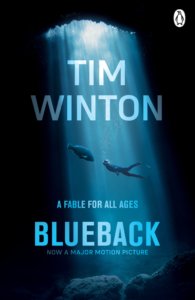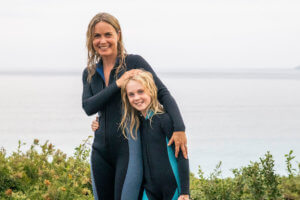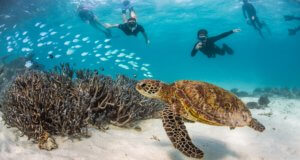Tim Winton knew that humans were damaging the sea when he wrote his 1997 novel Blueback, even while he did nothing about it. As an adaptation comes to the silver screen, he reflects on how the book’s protagonist has haunted him all the way to Ningaloo Reef.
MY FIRST look at Robert Connolly’s film adaptation of Blueback, the little novel I published in 1997, was a private screening, so I took the tribe. It’s rare for me to mix work and clan like this, but the book occupies an unusual place in my life and in our family. Also, Robert’s an accomplished producer and director – Balibo, The Dry and an audacious version of my book The Turning – so I figured we were in safe hands, and thought it might be fun for us to see it together. But as four generations of us filed into the lobby of the little cinema, I was suddenly conscious of the passage of time this gathering represented.
 The book is about a family’s special relationship with nature, in the form of a giant fish, the groper whose name became the title. When I wrote it, my kids were children. Now here they were, with their own kids in tow. Back in the 1990s, my parents were in spry middle age. Today they needed to be helped upstairs and settled gingerly into their seats by my nieces and nephews, who weren’t even born when the book came out.
The book is about a family’s special relationship with nature, in the form of a giant fish, the groper whose name became the title. When I wrote it, my kids were children. Now here they were, with their own kids in tow. Back in the 1990s, my parents were in spry middle age. Today they needed to be helped upstairs and settled gingerly into their seats by my nieces and nephews, who weren’t even born when the book came out.
Having your work reviewed is like standing by politely as a stranger rifles through your belongings. Seeing adaptations is less dreadful, it’s true, but not much less. As I waited white-knuckled for the lights to dim, I began to wonder if this tribal screening had been such a good idea.
ROBERT’S INTEREST in Blueback stretches back 20 years. Any time I mentioned the prospect of this adaptation, people would invariably ask the same question: “How will they get the fish right?” Because a blue groper is not the sort of creature you can train for the movies.
Initially, Robert assumed his movie would need to be an animation. Which made sense. But here we were, about to see a live-action film. After I’d prepped everyone with the news that the title role would be played by a puppet, my grand-daughter said: “But, Timmy, you can’t make a puppet swim in real water!” Well, it turns out you can. And beautifully. The puppet, let me say, is a triumph.
But Blueback is not a tale about a fish. It’s about a woman. A courageous and determined widow called Dora Jackson. She’s the moral centre of the story. Yes, there’s a big fish in it. A kid, too. But, essentially, it’s a story about Dora’s battle to save her home place from greedy developers. Her ideals and actions challenge and inspire her child from infancy into middle age. So, for me, it’s about a hero.

Blueback the movie ©Roadshow Entertainment.
“We come from water,” says Dora, “we belong to it.” When I first wrote that line, it arrived with a strange jolt of recognition. Now I can see why. I must have got it from American marine biologist and writer Rachel Carson, one of my own heroes. She’s best known for her 1962 tome Silent Spring, but her grand classic is the 1951 book The Sea Around Us. Carson called the ocean “the great mother of life”. And she’s right. We’re all children of the sea. Not simply because of our evolutionary origins, but because our fate is inextricably linked to the fortunes of the sea: when it dies, so do we.
I WROTE Blueback in a week. It slipped out whole. Fully formed. Like a shark or a newborn child, it was swimming before it was born. And it’s never been out of print.
In writing it, I knew I was reaching back to the child I’d once been, the awestruck boy for whom the world was still enchanted. But now I see I was also reaching forward, to the man I was yet to become. Because I’ve been swimming in that book’s wake ever since. It changed the shape of my life.
When I wrote Blueback, I was painfully aware that the sea around us had become much sicker and poorer since Rachel Carson’s day. Our mother, the sea, had become our mine and our toilet. I felt a sense of impending doom at its plight. But I never did anything about it. Changing things felt like someone else’s job.
So I wrote my little story. And that was that. On to the next thing. But Dora Jackson haunted me. And held me to account somehow. Which is an odd experience to have: being shirtfronted by a figment of your own imagination.
Many of us experience the natural world as little more than a backdrop to our lives. We’ve reduced landscapes and ecosystems to settings and locations. Creatures within them are mere objects.
But not for Dora. To her, it’s a subject, a character, the most consequential player in her drama. So when she says she belongs to the sea, Dora’s suggesting more than a moment’s appreciation. She’s talking about bonds of allegiance. Family obligations. And she embraces these faithfully and bravely.
“We come from water. We belong to it.” There was a kind of thrill in that line. Was I confessing something through Dora? Or was she holding me to account? Maybe it was both. Because by then I knew I needed a more filial relationship with the natural world. Particularly with the ocean, which is central to my life and my work. I always knew I was a child of the sea. It nurtured me, fed me, comforted me. But I never felt any sense of obligation towards it. Like most kids, I thought the great mother was my servant. I was a long way into adulthood before I outgrew that mindset.

Ningaloo Reef ©Blue Media Exmouth
You see, I was formed by the limestone shores of Western Australia’s mid-west. And educated by the granite coast that fronts the cold fury of the Southern Ocean. But the place that matured me was way up in the arid north-west. This is where my doomy passivity was overrun by a big blue wave of hope. And the source of that wave? Ningaloo Reef.
THE FIRST time I swam through the coral gardens of Ningaloo, I was poleaxed by what oceanographer Callum Roberts calls the twin pillars of biodiversity: variety and abundance. One minute, I was sculling beneath a shark the size of a bus. Next, I was inside a cloud of glassfish transformed in an instant to a million shards of glittering hail. The water was literally fizzing with life. At Ningaloo, I saw what the world looks like when it’s still itself. And in the wake of that experience, I felt an infusion that fed my imagination. As an artist. And later, as a citizen.
I wrote my little book. And a couple of years afterwards, I was living in it. Helping defend Ningaloo. From actual developers. It was a sharp turning.
So, how do you defend an ecosystem? Well, the best way you can. I was an artist, trained to be a spectator, so really, I had no clue. I took counsel from more experienced comrades whenever I could, but often as not, in lieu of any other role model, I was left channelling Dora. Yes, I know. It’s kind of embarrassing. Was she an example, or a rehearsal? I still don’t know.
In Blueback, Dora’s caught in an uneven struggle with folks who want to turn an ecosystem into money. What she sees as family, they see as stuff to buy and sell. Dora does the only thing she can. She defends Longboat Bay as if it were kin. And that was my touchstone.
Dora has no idea what she’s doing. She’s forced to make it up as she goes. She fakes it until she makes it. She learns to fight. And fights in order to learn how. She was my hero. In the book. And beyond it, in ways I could never have anticipated.
By Tim Winton
Credits to Nine publishing
Learn more about BLUEBACK the movie and blue gropers here!